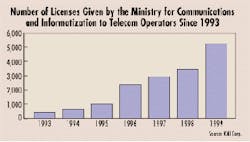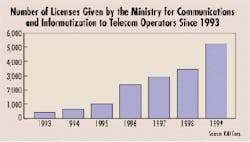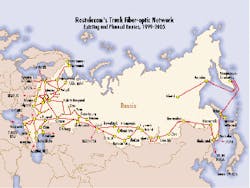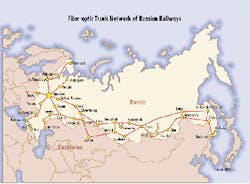Emerging fiber-optic markets in Russia
Privatization and profit potential are spurring significant investments and growth in Russian telecommunications.
RICHARD MACK, KMI Corp.
Fiber-optic technology is developing rapidly in Russia, based upon cooperative joint ventures with energy utilities, railway departments, and regional telecommunications carriers. The most attractive investments in Russian telecommunications are arising from the privatization of former state enterprises into share-stock companies and the opportunity for profit-driven growth, according to market researcher KMI Corp.'s latest report, "Fiberoptics Markets in Russia, March 2000."
In 1999, the Ministry for Com muni cations and Informatization (formerly the State Committee for Telecom munications) granted 1,700 new licenses to provide communications services, bringing the total number of licenses granted to 5,200 (see Figure 1). Despite delays in some regional projects due to Russian economic difficulties in 1998, the largest growth is in the Moscow region where 20.3% of the licenses were issued, including 10.2% within the city. Also in Russia's top 10 growth regions are Krasnodarsky Krai (6.2%), St. Petersburg (5%), Ekaterinburg (4.9%), and Sverdlovskaya (4.9%).Figure 1. Of the 5,200 licenses granted by Russia's Ministry for Communications and Informatization since 1993 to provide communications services, nearly one-third were issued last year alone.
Since 1993, nearly 10 million telephone lines have been activated. Advanced communications are being rapidly implemented in Russia, with the number of cellular telephones (396,400 to 730,000) and pagers (280,000 to 450,000) nearly doubling in just one year (1998 to 1999).
In August 1998, an economic crisis reshaped the flow of foreign and domestic investments into Russian telecommunications. This difficult economic situation caused many regional operators tariff and payment problems with accumulated debts to vendors. Following the crisis, large debts to foreign suppliers for deployment of fiber-optic cable were restructured. The quick revival of fiber-optic cable manufacturers and installers after the August 1998 crisis is a strong indicator of the Russian market's large potential.
Conservative forecasts for growth in Russian telecommunications over the next five years project aggregate gains of 45.5% for trunk networks and 65% for regional networks, local area networks (LANs), other data communications, and cable TV. With continued strengthening of the Russian economy, these forecasts will improve by as much as 15%-20%. Data communications is a particularly high growth area, with projected expansion of 20%-30% in annual growth rate over the next five years.Figure 2. Rostelecom's completed 4,000-km fiber link is part of the TransSiberian project using aerial cables along energy company corridors in the region. Plans are to deploy 8,000 km of fiber-optic cable annually.
Rostelecom is the biggest fiber-optic cable installer and a key player in implementing fiber-optic systems in Russia (see Figure 2). Last year, Rostelecom finished building a 4,000-km fiber link, which is part of the TransSiberian project using aerial cables along energy company corridors in the region. Rostelecom's long-distance focus has attracted investors to build several fiber-optic systems for international communications, including a national trunk network, where only 54% of installed capacity was being used in 1998.
Since 1998, Rostelecom intensively started to develop fiber-optic networks and feeder links to connect all regional operators to its digital network. Due to the efforts of Rostelecom, the digitalization of long-distance communications in Russia has reached 70% by the end of last year. Rostelecom plans to deploy 8,000 km of fiber-optic cable annually. In addition to its trunk telephony services, Rostelecom has intensively developed its data-communications capacity.
Several major users also appeared on the market in 1997, including the United Energy System Russian Joint-Stock Co. (RAO EES), the huge Russian energy conglomerate Gazprom, and the Ministry of Railways. Based on new economic conditions, these companies and their regional telecom companies have some independence in the development of their communications infrastructure. Local computerized management systems combine to form a common corporate network to serve these important fiber-optic customers.Figure 3. Railways will be the second major fiber-optic deployer in Russia through 2005.
Railways will be the second major fiber-optic deployer in the next five years (see Figure 3). Transtelecom, the general contractor and future operator of railway communications, has announced plans to deploy between 35,000 and 37,000 km of fiber-optic cable using $1 billion to $2 billion in investments by next year. The business plan for this ambitious project was developed by U.S. consulting firm Ernst & Young; the equipment suppliers include Lucent Technologies, Alcatel, Ericsson, Siemens, Pirelli, and GPT. Transtelecom's network will compare with that of Rostelecom and have capacity reserves using WDM technology.
As part of the Transtelecom project, Zapadno-Sibirskaya (West Siberian) Railway installed a suspended or buried 12-16-fiber link between Omsk and Novosibirsk along the railway. RAO EES and Gazprom also plan to build nationwide fiber-optic networks with more than 20,000 route-km and 10,000 route-km, respectively. The construction of these new systems promises new possibilities for Russian telecommunication markets as well as suppliers of fiber-optic systems and cables. Applications such as railways, energy utilities (RAO EES), and gas and oil companies-segments that traditionally have ready access to rights-of-way-have the greatest immediate growth prospects.
The railways and communications divisions of large energy companies are leading new installations, including Sverdloskaya Railways, which completed a 2,500-km fiber-optic network connecting main cities in the region.
Gaztelecom, general contractor for construction of the ground network and a subsidiary of Gazprom, received licenses to provide local communications in 53 regions, and applications for a trunk license are expected to be approved. Gazprom, the largest corporation for gas extraction and transportation, has planned a 48-fiber 2,500-km fiber-optic link installed along gas pipelines linking cities in Belorussia, Poland, and Germany (namely Berlin). Pirelli is the likely supplier of the cable using WDM technology. Gazprom's three-stage expansion plan includes $2 billion in communications investments, according to the KMI report.
COMCOR, operator of a 2,000-km fiber-optic network in Moscow, plans to expand the system connections to neighboring towns with a 32-fiber cable forming a system that could reach 2,800 km.
One aspect of the fiber market in Russia is the entry of international trunk operators. Last year, Sonera (Finland) built a 1,000-km fiber-optic link together with several regional operators of energy utilities. Sonera became the first international operator to build a domestic link with Russia, reflecting a continuation of the liberalization process in Russian telecommunications.
GTS Access Service (United Kingdom) is currently building a fiber-optic ring through Moscow and Kiev, as part of the TransEuropean Network, connecting St. Petersburg with Tallinn (Estonia) and Helsinki (Finland).
Other fiber-optic cables will be installed from Warsaw (Poland) to Kiev (Ukraine) to Moskow by Opten Ltd. In the next year, several new international fiber-optic links to Belorussia, Ukraine, Kazahstan, Georgia, Azerbadjan, and Poland are planned.
RAO EES (registered October 1993) is a joint venture of Oktyabrskaya Railway State Enterprise, Vysokoskorostnie Magistrali (High-Speed Railways) Joint-Stock Co., and Andrew Corp. (United States). The main activity of the company is leasing international circuits for transmitting telephone, television, data or telemetric information channels as well as providing communications for the Oktyabrskaya Railway. Building international trunk networks opens up a competitive environment for regional operators.
The future of Russian cable TV is not clear. While there are more than 400 television operators in Russian, few use fiber-optic cable systems. In 1999, cable-TV and data-communications segments did not exceed 3% to 5% of the total fiber-optic-cable installations. The main problem for the development of cable-TV networks is the low density of the population. The building of fiber-optic or hybrid fiber/coax TV networks is viable only in big cities where it is possible to deploy wideband networks that can also be used by local and datacom operators. In recent years, several fiber-optic cable-TV networks were built in medium-sized cities. If the experience of these operators is successful, investments will come to this sector.
The current length of fiber-optic links in Moscow Metro is about 650 km. Connecting the fiber-optic cable to other switching centers outside the metropolitan area and to major subscribers results in a fiber-optic network that exceeds 1,500 km. Carriers with plans for greater than 700 km of fiber-optic cable in Moscow in the next five years include Moscow City Telephone Network (MGTS), Macomnet, Comstar (a joint Russian-British venture), PTT-Teleport Moscow, Sovintel (Russia-United States), and Telmos JV, MGTS, Rostelecom, and AT&T (United States). Other international major players in Russian telecommunications include Global One and Golden Line.
Telmos, an MGTS and AT&T (U.S.) company, is a partner in a large network modernization program called the Golden Bullet Project, which has added 420,000 digital lines to the Moscow City Telephone Network. Lensvjaz is one of the top 10 telecom companies in Russia providing services in the Leningradskaya region.
Global One has 270 access nodes in more than 200 major cities in Russian and other CIS countries servicing domestic and foreign companies, government, mass media, and approximately 800 banks.
By late last year, the volume of information handled by the network was 2 Gbits/sec per day.
Golden Line, a Russian-Canadian joint venture, services major customers such as AT&T, British Telecom, Deutsche Telekom, Sonera, France Telecom, PTT Netherlands Telecom, Swiss Telecom, and Telecom Denmark, as well as main Russian long-haul and datacom operators. Sovintel, a Russian-U.S. joint venture, provides service to more than 50,000 subscribers, with major customers such as IBM, Credit Swiss, Nestle, Pepsi, Lukoil, and the Central Bank of Russia, as well as the larger hotels such as Metropol and the Savoy.
The main foreign investors to Urasvjazinform Joint-Stock Co., the largest telecom company operating in the west Ural region, are Alcatel Telecom, Siemens (Germany), Nokia (Finland) and Hanwha (South Korea).
Following the economic recovery from the August 1998 crisis in Russia, cable manufacturers have become more aggressive in gearing up for production, offering new cable designs and open price lists for standard cable configurations. During 1998-99, several new fiber-optic-cable manufacturers appeared on the market. Key players include Corning and Fujikura, which have provided fiber to Optika-Kabel and Opten Yauza-Kabel. Corning provides cable to Samara Optical Cable Co. and Transvok. Lucent Technologies' joint venture with Svjazstroy-1 in Voronezhwas was announced last year.
Fiber-optic-cable production is expected to nearly triple from 259,700 to 725,000 km within the next five years, with Elecktroprovod and Optika-Kabel leading fiber-optic-cable manufacturing. Elektroprovod, the leader in fiber-optic-cable production supplied 50,000 fiber-km last year.
Of the new domestic manufacturers in Russia, Myassky Machine Building Plant is producing high-quality quartz-glass preforms.
As well, a manufacturing collaboration between Samara Optical Cable Co. and Corning was established in 1997, with investments from Swisscab (Switzer land) and Mali (Austria).
Richard Mack is vice president and general manager at market research and analysis firm KMI Corp. (Newport, RI). For a copy of the report, "Fiberoptics Markets in Russia, March 2000," contact KMI at www.kmicorp.com.



